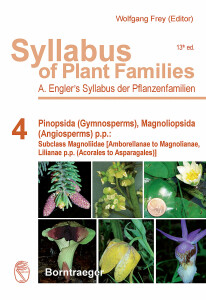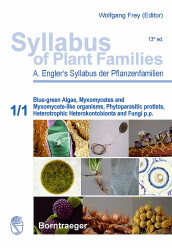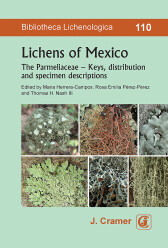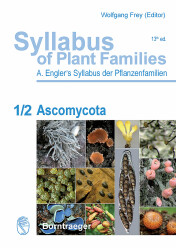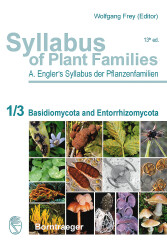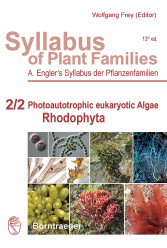Syllabus of Plant Families - A. Engler's Syllabus der Pflanzenfamilien Part 4:
3 545,45 Kč vč. DPH
3 545,45 Kč bez DPH
Pinopsida (Gynosperms) Magnoliopsida (Angiosperms) p.p.: Subclass Magnoliidae [Amborellanae to Magnolianae, Lilianae p.p. (Acorales to Asparagales)]. Orchidaceae
|
Country | % VAT (books) | % VAT | |
|---|---|---|---|
| DEU | 7 | 19 | |
| HUN | 5 | 27 | |
| AUT | 10 | 20 | |
| BEL | 6 | 21 | |
| BGR | 9 | 20 | |
| DNK | 25 | 25 | |
| EST | 9 | 20 | |
| FIN | 10 | 24 | |
| FRA | 5,5 | 20 | |
| HRV | 5 | 25 | |
| IRL | 0 | 23 | |
| ITA | 4 | 22 | |
| CYP | 5 | 19 | |
| LTU | 9 | 21 | |
| LVA | 5 | 21 | |
| LUX | 3 | 16 | |
| MLT | 5 | 18 | |
| NLD | 9 | 21 | |
| POL | 5 | 23 | |
| PRT | 6 | 23 | |
| ROU | 5 | 19 | |
| GRC | 6 | 24 | |
| SVK | 10 | 20 | |
| SVN | 5 | 22 | |
| ESP | 7 | 21 | |
| SWE | 6 |
25 |
Cena platí pouze pro české zákazníky. Vzhledem k novému nařízení Evropského parlamentu musí být konečná cena od 1. července 2021 kalkulována podle země konečného určení. Platnou sazbu DPH ve vaší zemi naleznete v tabulce výše.
https://ec.europa.eu/taxation_customs
Záruka (měsíce): 24
Dostupnost: Do 14 dnů
2015. 13. edition, XI, 495 pages, 2 tables, 127 mostly coloured figures, 17x25cm, 1280 g
Language: English
Part 4 of Engler’s Syllabus of Plant Families – Pinopsida (Gymnosperms) and Magnoliopsida (Angiosperms) p.p.: Subclass Magnoliidae [Amborellanae to Magnolianae, Lilianae p.p. (Acorales to Asparagales)] provides a thorough treatise of the world-wide morphological and molecular diversity of the Gymnosperms and the first part of the Angiosperms [Magnoliidae: Amborellanae to Magnolianae, Lilianae p.p. (Acorales to Asparagales).]
The description of the Gymnosperms, including the extinct diversity, is the first synthesis of classical anatomical-morphological characters with modern molecular data, combined with the numerous new discoveries of fossils, especially from China, made during the last ten years.
The Angiosperms are the most diverse group of plants and form nearly 95% of the global vegetation from arctic tundra, resp. subantarctic vegetation formations, to tropical rainforests. There is actually no comprehensive survey covering all families and genera of angiosperms. Engler’s Syllabus is an attempt to fill this gap by covering all angiosperms in two volumes arranged according to the most recent phylogenetic system of APG III (2009). In this first volume (Part 4 of the Syllabus) all families and genera of Magnoliids are described. The monocotyledonous families are covered by the orders Acorales and Alismatales as well as all groups of Liliid orders and families (Petrosaviales, Dioscoreales, Pandanales, Liliales and Asparagales). The Orchidaceae are included with a fully revised and modern treatise, thus representing one of the two most species-rich families of plants. The remaining monocotyledonous groups (Arecales, Commelinales, Poales, Zingiberales and Dasypogonales) and the core eudicotyledons will be treated in Part 5 of the Syllabus of Plant Families. This up-to-date overview of the Pinopsida (Gymnosperms) and Magnoliopsida (Angiosperms) p.p. (Subclass Magnoliidae p.p.) will be of service in the reference literature for a long time.
Engler’s Syllabus of Plant Families has since its first publication in 1887 aimed to provide both the researcher, and particularly the student with a concise survey of the plant kingdom as a whole, presenting all higher systematic units right down to families and genera of plants and fungi. In 1954, more than 60 years ago, the 12th edition of the well-known „Syllabus der Pflanzenfamilien“ (“Syllabus of Plant Families”), set a standard.
Now, the completely restructured and revised 13th edition of Engler’s Syllabus published in 5 parts and in English language for the first time also considers molecular data, which have only recently become available in order to provide an up-to-date evolutionary and systematic overview of the plant groups treated.
In our “molecular times” there is a vitally important and growing need to preserve the knowledge of the entire range of diversity and biology of organisms for coming generations, as there is a decline in “classical” morphological and taxonomical expertise, especially for less popular (showy) groups of organisms.
Accordingly, the 13th edition of Syllabus of Plant Families synthesizes both modern data and classical expertiseserving to educate future experts who will maintain our knowledge of the full range of Earth’s biodiversity.
Syllabus of Plant Families is a mandatory reference for students, experts and researchers from all fi elds of biological sciences, particularly botany.
Abbreviations, Symbols IX
1 Introduction 1
2 Pinopsida (Gymnosperms) and Magnoliopsida (Angiosperms) 2
3 Pinopsida (Gymnosperms, Gymnospermopsida, Gymnospermae) 6
Characterization and relationships 6
Synopsis of classification of the Spermatophytes 11
Systematic arrangement of taxa of the Pinopsida (Gymnosperms) 13
Pinopsida (Gymnosperms) 13
“Pteridospermatidae” 14
Cycadidae 22
Ginkgoidae 38
Gnetidae 47
Pinidae 55
4 Magnoliopsida p.p. (Angiosperms, Angiospermae) 111
Magnoliopsida 113
Characterization and relationships 113
Synopsis of classification of the Magnoliipsida 125
Systematic arrangement of taxa 131
Magnoliopsida 131
Magnoliidae 131
Amborellanae 131
Amborellales 131
Nymphaeanae 133
Nymphaeales 133
Austrobaileyanae 140
Austrobaileyales 140
Magnolianae 144Chloranthales 144
Canellales 145
Piperales 148
Laurales 159
Magnoliales 174
Lilianae 200
Acorales 201
Alismatales 203
Petrosaviales 240
Dioscoreales 241
Pandanales 252
Liliales 263
Asparagales 283
5 Taxonomic novelties 466
Sources of Illustrations 467
Index to Taxa 468
 čeština
čeština

